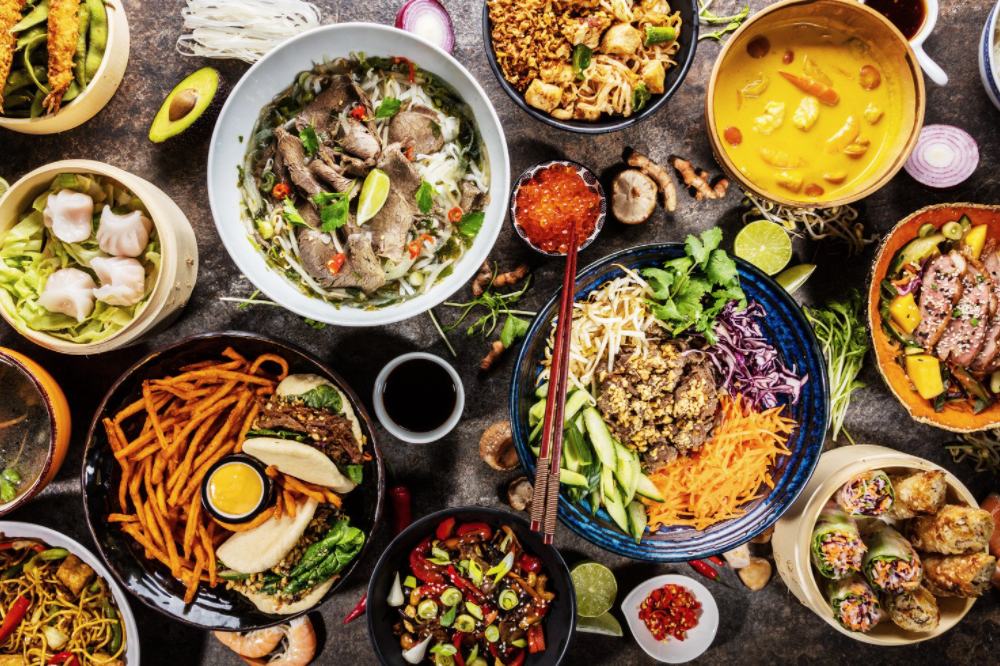Thai food, with its explosive flavors and harmonious blend of sweet, sour, salty, and spicy, has transcended its homeland’s borders to become a global culinary sensation. From bustling Bangkok street stalls to Michelin-starred restaurants in New York City, Thai cuisine has not just delighted but conquered taste buds worldwide. Its meteoric rise to international acclaim is no mere happenstance; rather, it stands as a testament to the unique qualities that set Thai food apart.
In this comprehensive exploration, we will delve deeper into the cultural, historical, and gastronomic factors that contribute to Thai cuisine’s irresistible appeal, uncovering six compelling reasons why it has not only earned but firmly retained its place as one of the most cherished and influential global cuisines.

Complex Flavor Profiles
One of the most captivating features of Thai cuisine is its artful mastery of intricate flavor profiles that waltz on the palate with unparalleled finesse. The delicate balance of sweet, sour, salty, and spicy notes in signature dishes such as Tom Yum Goong (spicy shrimp soup) or Pad Thai (stir-fried noodles) is nothing short of culinary alchemy. This harmonious interplay of flavors stimulates taste buds in a symphony that few cuisines can replicate.
It’s an explosion of sensations, from the fiery kick of chili peppers to the soothing embrace of coconut milk in a green curry. The sheer complexity and equilibrium in Thai food make every meal an exhilarating adventure, a symphony of tastes that lingers in memory and beckons diners to return for more.
Fresh Ingredients and Vibrant Herbs
Central to the allure of Thai cuisine is its unwavering commitment to employing fresh, locally sourced ingredients. Thai chefs place a premium on the use of the highest-quality produce, herbs, and spices available. The vibrant green of basil leaves, the aromatic scent of lemongrass, and the fiery heat of Thai bird’s eye chilies all contribute to the sensory experience.
The use of fresh herbs like cilantro, mint, and Thai basil imparts an unmistakable freshness to dishes, creating an explosion of aroma and flavor that captivates diners from the very first bite. This steadfast dedication to using the finest ingredients ensures that Thai food is not only a culinary delight but also a nutritious and wholesome choice.

Street Food Culture
A linchpin in popularizing Thai food across the globe is Thailand’s vibrant street food culture. The bustling streets of Bangkok and other Thai cities teem with food vendors peddling a dizzying array of delectable dishes. These street-side maestros offer affordable yet scrumptious meals, rendering Thai food an accessible delight for people from all walks of life.
Whether one opts for a swift serving of Pad Thai from a modest cart or a savory indulgence of som tam (green papaya salad) from a bustling market stall, the street food milieu in Thailand possesses an irresistible charm that beckons even the most discerning palates. This culture has not merely introduced people to Thai flavors; it has, in many ways, shaped and influenced international street food trends.
Cultural Appeal
Beyond its exceptional culinary attributes, Thai food offers a cultural journey that heightens its global allure. Dining in a Thai restaurant often entails an immersive experience that includes traditional decor, warm and welcoming service, and, at times, captivating live music and dance performances.
This holistic encounter enables diners to forge a deeper connection with Thai culture, elevating their meal into a memorable odyssey. Furthermore, the practice of sharing dishes, intrinsic to Thai dining, fosters a sense of togetherness and conviviality that many find irresistibly enchanting.

Culinary Diversity
Thai cuisine boasts incredible diversity, with regional variations that mirror Thailand’s rich cultural tapestry. From the fiery dishes of the Isaan region in the northeast to the seafood marvels of the coastal areas, each facet of Thailand offers a unique culinary experience. The breadth of Thai food means there’s something to satiate every palate, whether one’s preferences lean toward the rich and creamy curries of the southern provinces or the pungent and fiery dishes of the north. This rich tapestry of flavors has enabled Thai cuisine to cater to a wide spectrum of tastes, rendering it accessible and appealing to a global audience seeking novelty and adventure on their plates.
Health Consciousness
In an era where health consciousness is on the ascent, Thai food has surged ahead thanks to its unwavering commitment to fresh ingredients and well-balanced flavors. Numerous Thai dishes feature lean proteins such as chicken, shrimp, and fish, thoughtfully paired with an abundance of vegetables and herbs. The deployment of aromatic herbs and spices not only amplifies flavor but also imbues nutritional value.
Additionally, Thai cuisine frequently aligns with gluten-free dietary preferences and comfortably accommodates various dietary choices, including vegetarian and vegan. This health-conscious approach has resonated profoundly with global consumers who yearn for meals that are not just tantalizing to the taste buds but also beneficial for overall well-being.
Conclusion
The conquest of taste buds worldwide by Thai food is no serendipitous event. Its complex flavor profiles, unwavering commitment to fresh ingredients, culinary diversity, vibrant street food culture, health-consciousness, and cultural appeal have combined to fashion it into an irresistible global phenomenon. As individuals from every corner of the world continue to explore and wholeheartedly embrace the wonders of Thai cuisine, it becomes abundantly clear that this culinary treasure will remain ensconced as one of the world’s most cherished and enduring gastronomic traditions. So, the next time you savor a plate of Pad Thai or relish the fragrant embrace of a green curry, remember that you’re not merely enjoying a meal; you’re participating in a global culinary love affair that exhibits no signs of waning. Thai food has not just conquered taste buds; it has captured hearts and souls, becoming a culinary journey that traverses borders, uniting people through the universal language of flavor.



